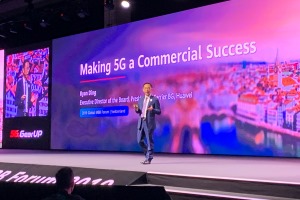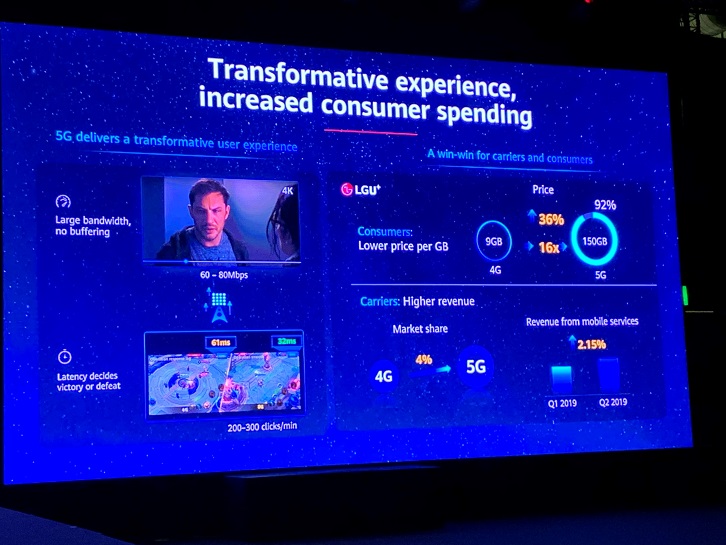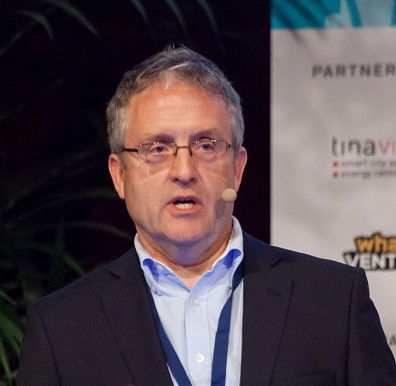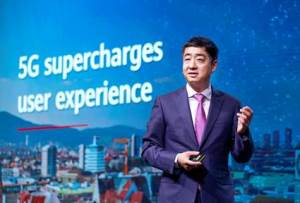A WEEK IN TELCO IT – 5G is starting strong, says Huawei. The company’s deputy chairman, Ken Hu, told its annual Mobile Broadband Forum (#MBBF) in Zurich, Switzerland last week that 5th Generation mobile communications “arrived faster than expected,” and that there are now 40 carriers in more than 20 countries supporting 136 different 5G-enabled devices.
At first glance, the rapid take-up of 5G in China and South Korea during 2019 suggests Hu is correct, but not all is rosy in the 5G garden, says Jeremy Cowan. Huawei has seen early wins in China and South Korea – as has Ericsson – but the Chinese vendor is making slower progress in Europe and is shut out of the US market entirely.
Worst hit, though, has been Nokia which this week cut its profit forecasts for 2019 and 2020, postponed dividends until further notice, and belatedly ramped up its 5G investments. Nokia also complained that its rivals are sacrificing profits for 5G market share. It is either unwilling or unable to play that card.
Large scale early 5G deployments in Asia have not been matched in Europe. Finland-based Elisa Oyj claimed to be the first telco in the world to offer a commercial 5G service, a handful of cities have coverage in Germany and Italy, while Spain and the UK are served in 20 cities by Vodafone and BT, with smaller footprints for other telcos. In the US, for example, AT&T offers mobile 5G for some customers in 21 cities, while T-Mobile expects to have nationwide coverage by the end of the year.
The Chinese market for 5G is big and getting bigger. While it’s often true that pressing the Start button for new infrastructure roll-outs happens faster in a Command Economy like China than in, say, India or Brazil, there’s no doubt the Chinese Government has embraced 5G like few others.
Consumer demand?
In the private sector, telcos learned from the launch of 3G and 4G that consumers will only embrace next gen technology when they see compelling benefits. Being able to download a movie in 1.2 seconds instead of two minutes won’t be enough to entice most people into 5G, particularly when device choice remains low and the tariffs are relatively high. For example, Verizon was the first operator in the USA to offer 5G and, as GSMA Intelligence reported in June, “its average tariff is the lowest of any of the investigated unlimited plans. Prices are an average of US$18 higher than 4G, but come with free roaming in Canada and Mexico along with Apple Music.”
One key selling point, say network equipment vendors, is the low latency in 5G services. And there’s one consumer group above all others that may be lured by this. You’re way ahead of me: Gamers. But, to date, operators are finding far greater success in the enterprise market, connecting Things not people.

Ryan Ding, executive director of Huawei’s Board and president of the carrier business group, noted that in just one year, standards, spectrum, and devices have all become 5G-ready, a speed not seen in previous generations of mobile communications. In early 2019, South Korea became the first country to launch 5G services nationwide. A few months later, China also launched 5G services and is now on course, he reported, to build 600,000 to 800,000 5G base stations by the end of 2020.
To date, 56 carriers around the world have built 5G networks and 40 of these have launched 5G services. Ding said that Huawei has won more than 60 5G contracts and already shipped over 400,000 5G active antenna units (AAUs). For comparison, Ericsson now has 70 commercial 5G agreements or contracts with unique communication service providers, of which 20 are live networks.
As the number of 5G-enabled devices on the market grows beyond Huawei’s latest count of 136, Ding is confident that the costs will fall. 5G smartphones are, he said, currently priced at about US$500, but he expected that to fall to around $350 by the second half of 2020. If the GSMA’s forecast of 1.57 billion users of 5G by 2025 proves accurate, he may well be right. Huawei itself expects there to be 480 million households worldwide using 5G to support Fixed Wireless Access (FWA) by the same date.
What will drive this uptake?
Ding pointed to a “transformative experience” leading to increased consumer spending. He said consumers with Korean telco LG U+ are enjoying a lower price per Gigabit than in 4G and added there’s no buffering through greater bandwidth. He also claimed a 2.15% rise in revenues for the 5G carriers, between Q1 and Q2, 2019, but it remains to be seen if this will be consistent among carriers and over longer time frames.

There could be a big role for “5G + Fibre” in territories across Europe, where approximately 70 million households are currently either unconnected or underserved. The EU is falling behind its own internet speed target of 100% availability of 30Mbps by 2020. By 2018, only 40% of homes met this standard (Source: European Court of Auditors and Huawei MI). Carriers can now provide a fibre-like broadband experience using 5G Fixed Wireless Access to quickly meet householders’ needs.
In the consumer market, 5G’s large bandwidth and low latency will also enable new services like augmented / virtual reality (AR/VR), live streaming, video, and gaming. According to Ding, this is the transformative experience for which users are willing to pay a premium. He added that carriers can also use find new ways of monetising their services through 5G’s new metrics, for example by charging different rates for different latency tiers, and offering value-added content tailored to the local market.
Meanwhile, in the business-to-business (B2B) market some industries are expecting 5G to guarantee service level agreements (SLAs) are met. Businesses have defined territories, service models, and use cases for 5G applications, so carriers can offer 5G capabilities such as latency, uplink and downlink bandwidth, and reliability, in SLAs.
Early results are in
Huawei’s third-quarter revenue, announced on October 16th, climbed 27% year on year. This was reportedly driven by growth in shipments of smartphones launched before the US trade blacklisting led by President Trump. The company, now the world’s largest manufacturer of telecoms equipment, did not break down the Q3 figures. It is, however, trying to reduce its reliance on foreign technology, and said in September that it has started making 5G base stations without U.S. components.
Key rival, Ericsson also reported positive results. Organic sales grew by 3% in the third quarter of 2019, “driven by the early adopters of 5G, in North America and North East Asia,” said the Sweden-based company. Operating income was SEK 6.5 billion (US$670 million), a margin of 11.4% excluding one-off costs. Ericsson also reported that Korea’s LG U+ operator had selected it to provide 5G Radio Access Network (RAN) and 5G Core.
 Despite Huawei’s strength in its home market, Ericsson said, “The largest market for 5G infrastructure will be China where deployments are expected to start near term. We have invested to increase our market share, however it is still too early to assess possible volumes and price levels. Based on historic experience we expect to have challenging margins initially but positive margins over the lifespan of a contract.”
Despite Huawei’s strength in its home market, Ericsson said, “The largest market for 5G infrastructure will be China where deployments are expected to start near term. We have invested to increase our market share, however it is still too early to assess possible volumes and price levels. Based on historic experience we expect to have challenging margins initially but positive margins over the lifespan of a contract.”
“Over time, new exciting innovations for 5G will come with industrial and IoT use cases, leveraging the speed, latency and security characteristics of 5G. This provides opportunities for our customers to capture new revenues as they provide additional benefits to consumers and businesses. Our IoT business is growing almost twice as fast as the estimated market growth of 20-25% per year. We have more than 4,500 enterprises on our IoT platform and the number of connected devices on the platform has more than doubled year to date.
“To fully leverage our position and capture new recurring revenue streams we are increasing our investments in IoT within Emerging Business. With this investment, we do not expect to reach breakeven for the segment next year, and instead (will) incur losses of SEK 1.5 to 2.0 billion ($160 to $210 million),” an Ericsson spokesman concluded.
In contrast, to the bullish outlooks on 5G from the two market leaders’, under-investment has left Finland’s Nokia dogged by technical issues in its 5G offering. Nokia spooked the financial markets this week by suspending all dividends in order to find capital for greater investments in 5G. Shares plunged by 21% on news that key Nokia customers were limiting spending due to planned mergers in North America, its biggest 5G market.
New applications more than new markets
It will come as no consolation to Nokia that Huawei also expects this to be a slow journey to 5G profitability. “It will be a long process for 5G to enable industry digital transformation,” said Ding. “Carriers should develop new network capabilities, operational capabilities, and business models right now to embrace the B2B transformation.”
He concluded that “the best way to predict the future is to create it” and called upon carriers, regulators, vertical industry players, equipment vendors, and systems integrators to work together to build a thriving 5G industry.

On this much the vendors seem to agree. At MWC Los Angeles 2019 this week, Ericsson showed a paramedic using a haptic glove to perform an ultrasound examination through real-time interactive communication with a medical expert. Ericsson also remotely retrieved data from a smart vessel to test water quality and took measurements to tackle water pollutants.
Gamers may be in mainstream media headlines but, for now at least, 5G is more about delivering the Internet of Things.
The author is Jeremy Cowan, editorial director & publisher of VanillaPlus & IoT Now.
Comment on this article below or via Twitter: @VanillaPlus OR @jcvplus






